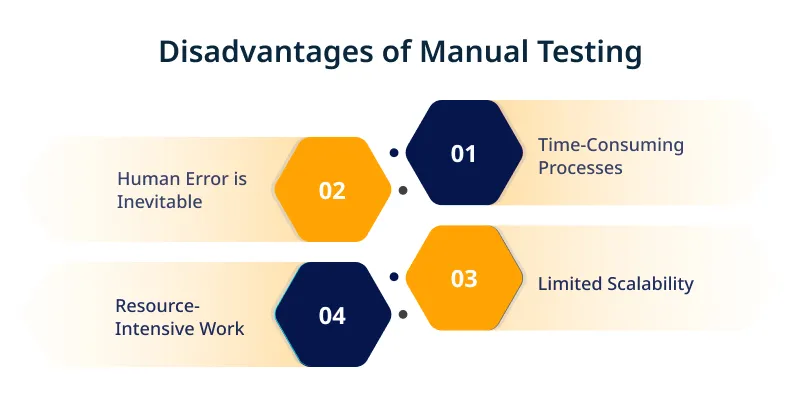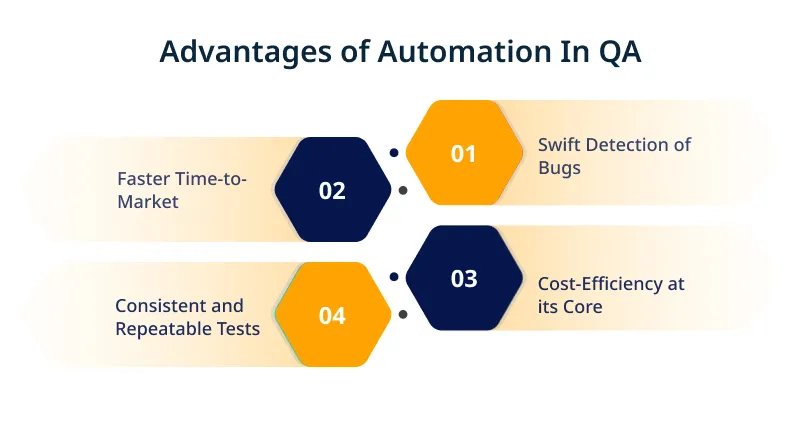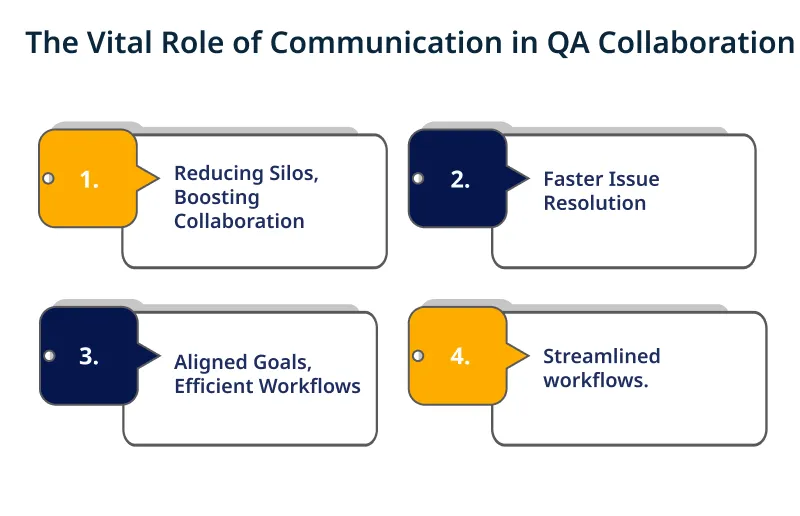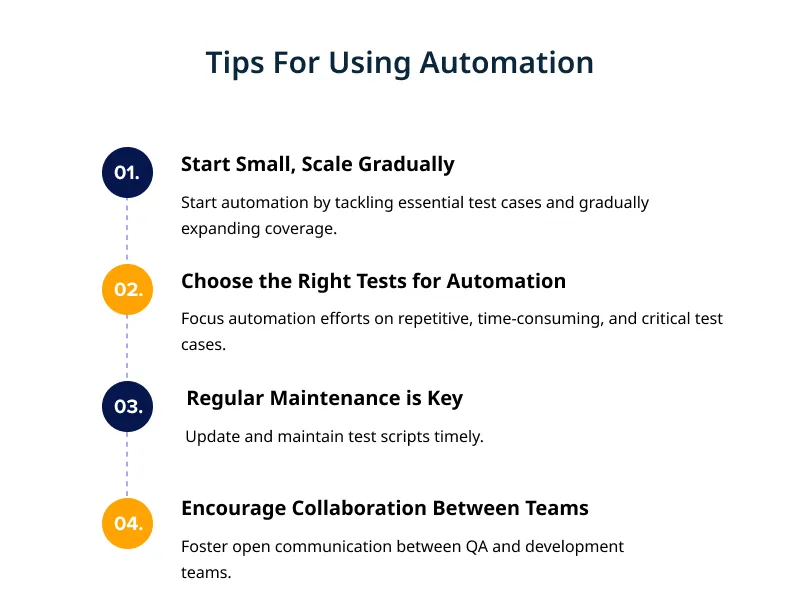Is your QA team struggling to keep up with the pace of development?
Well, manual testing often can’t keep up with today’s rapid release cycles which leaves businesses with question, how can they scale QA without compromising quality?
The answer is leveraging test automation. Studies show that organizations using automation in testing report increased efficiency.
According to a post, test automation has replced more than 50% manual testing efforts in 46% of the cases.
Implementing the right automation framework and strategy tailored to your delivery lifecycle can optimize QA bandwidth, reduce redundancies, and enable teams to focus manual testing on the most critical areas.
This allows stretching testing coverage and effort across an expanding test surface. The key is balancing automation and manual testing to enhance efficiency.
When done right, intelligent automation in QA enables more robust validation, protecting against defects and enhancing customer satisfaction.
KPMG stated in its report that the global test market is projected to grow between 7% to 12% CAGR between 2021 and 2025.
This blog provides practical approaches to leverage automation and augment QA efficiency without diluting quality. Here are key takeaways:
Key Takeaways From This Blog Post:
- Accelerating Testing Processes: Automation significantly reduces testing timelines, paving the way for quicker software releases.
- Improved Quality: Automated QA ensures consistent and repeatable tests, minimizing the chance of human error and enhancing overall software quality.
- Strategic Collaboration: Effective communication between QA and development teams is paramount, fostering collaboration for streamlined workflows.
- Practical Tips: Uncover actionable tips for successful automation implementation, from starting small to choosing the right tests.
Redefine your software testing journey with ValueCoders
Problems with Manual Testing
Manual testing, the conventional method of having real people meticulously check software, has its share of challenges that can slow down the entire development process.
Let’s break down these issues in a straightforward manner:
- Time-Consuming Processes: In manual testing, patience is a virtue. Testers go through each feature each line of code meticulously, which can take a considerable amount of time. This not only delays the overall development timeline but can also lead to missed deadlines.
- Human Error is Inevitable: Despite the best efforts of skilled testers, humans are prone to errors. In the manual testing realm, overlooking small but critical details happens, introducing the risk of releasing software with hidden glitches.
- Resource-Intensive Work: Manual testing demands a significant workforce, especially for large-scale projects. Hiring and managing a sizable testing team adds to the project’s expenses, making it a resource-intensive process.
- Limited Scalability: As projects grow, manual testing becomes increasingly challenging to scale. The more extensive the software, the more time and effort it takes to ensure every nook and cranny is error-free.
- Lack of Repeatability: Manual tests, once conducted, are challenging to replicate consistently. Each test run might yield different results based on human variations, making it difficult to ensure the reliability of the testing process.
- Scalability Constraints: Manual testing struggles to keep pace with the demands of rapidly expanding projects. The need for more human testers to cover additional functionalities can become a bottleneck, hindering the scalability of the entire testing process.
- Cost Overruns: The resource-intensive nature of manual testing directly impacts the project budget. Hiring and maintaining a large testing team and the associated training costs can lead to unforeseen financial burdens.
- Limited Test Coverage: Manual testing makes it challenging to cover all possible test scenarios comprehensively. Testers may focus on specific functionalities, leaving other areas unexplored, potentially resulting in undiscovered bugs.
When considering these challenges, it becomes evident that manual testing has its limitations. For industries like automotive, where precision and reliability are critical, Automotive Software Development often requires an even greater emphasis on automation to meet stringent quality standards and maintain safety.
The evolution towards Automation in Quality Assurance addresses these issues head-on, offering a more systemic and reliable alternative.
Explore our QA automation services designed to optimize your testing workflow.
How Automation Helps QA?
Adopting automation in Quality Assurance (QA) isn’t just a technological leap; it’s a strategic move to address the shortcomings of manual testing.
Here’s why and how automation is a game-changer:
1. Speeding up Testing Processes: Automation turbocharges the testing timeline. Repetitive tasks that took hours or days manually can be completed in a fraction of the time with software, accelerating the overall development cycle.
2. Consistency in Test Execution: Automation ensures that tests are executed identically every time, eliminating the variability introduced by human testers. This consistency is crucial for reliable and reproducible results.
3. 24/7 Testing Capability: Unlike humans who need breaks and sleep, automation tools can tirelessly run tests round the clock. This continuous testing capability is a significant asset in catching issues early and ensuring software stability.
4. Increased Test Coverage: Automation allows for the simultaneous execution of numerous test cases across different environments. This broadens the scope of testing, ensuring that various scenarios are covered and potential bugs are identified comprehensively.
5. Faster Time-to-Market: With manual testing, time is a constant hurdle. Automation catapults testing speed, significantly reducing the time needed for testing phases. This agility translates to quicker releases and a competitive edge in the market.
Incorporating automation isn’t just about using tools; it involves strategic thinking.
Also Read – How AI in Business Process Automation is Changing the Game
Here are some essential Strategies for effective QA automation and QA automation best practices:
- Identifying Suitable Test Cases: Not all tests are created equal. Focusing on automating repetitive and time-consuming tests maximizes efficiency.
- Regular Maintenance: Automation is an ongoing process. Regularly updating and maintaining test scripts ensures they stay relevant as the software evolves.
- Collaboration Between Teams: Effective communication between development and QA teams is paramount. Close collaboration ensures that automation aligns with the evolving software requirements.
Organizations often turn to Software Quality Assurance Services to make the most of automation.
These services provide expertise in implementing and optimizing automation processes tailoring strategies to the specific needs of a project.
In the subsequent sections, we’ll explore the nuts and bolts of software testing automation, getting into the practical aspects of implementing automation successfully.
ValueCoders' QA automation expertise ensures precision, speed, and reliability.
Now, let’s peek into the realm of QA automation techniques that unlock these benefits:
- Parallel Testing: Simultaneously running tests on different devices and environments amplifies test coverage, ensuring that your software functions seamlessly across various scenarios.
- Continuous Integration: Integrating testing into the development pipeline ensures that every code change undergoes automated testing, catching issues in their infancy.
Businesses can hire software QA testers or consider outsourcing to software testing services to get expertise. To leverage the benefits of automated QA without the headache of managing an in-house team, businesses always have the option to expand resources, especially for critical processes like integration testing, which ensures that different components of their systems work seamlessly together.
Also Read – The Ultimate Guide to Using Automation Tools in Software Development
Teamwork Makes the Dream Work – Communication is Key
The teamwork isn’t just a catchphrase; it’s the secret sauce that turns challenges into victories in Quality Assurance (QA).
Effective communication is the driving force that holds the entire QA process together. Here are some of the reasons why collaboration matters and how it fuels success:
- Reducing Silos, Boosting Collaboration: Silos, where teams operate in isolation, hinder progress. Effective communication breaks down these barriers, fostering collaboration between QA and development teams.
- Faster Issue Resolution: Clear communication ensures that when issues are detected through automated QA, they are communicated promptly to the development team. This agility in addressing problems prevents bottlenecks and accelerates the resolution process.
- Aligned Goals, Efficient Workflows: When QA and development teams are on the same page, goals align seamlessly. This alignment streamlines workflows, promoting efficiency and a smoother development lifecycle.
Also Read: Latest Trends Of QA Engineers Hiring: What To Look For Before Hiring QA Engineers
In the context of effective communication, consider the role of QA Consulting Services:
- Strategic Guidance: QA consulting services provide strategic guidance on communication protocols, helping teams establish effective channels and methods for exchanging information.
- Optimizing Workflows: Consultants can identify bottlenecks in communication workflows and recommend improvements, ensuring that information flows smoothly between teams.
For organizations looking to strengthen their QA communication game, particularly those considering global talent, options like Hire Software QA Testers India can bring diverse expertise into the mix.
The subsequent sections will delve into the practicalities of comparing QA automation tools, showcasing how effective communication dovetails with the benefits of automation in QA.
Experience a paradigm shift in QA efficiency with ValueCoders' expert automation services.
Making It Work – Tips for Using Automation
Implementing automation in Quality Assurance (QA) is a strategic move that needs thoughtful planning and execution.
Here are some practical tips to ensure your automation efforts meet your expectations:
1. Start Small, Scale Gradually
- #Tip 1: Start by automating a few essential test cases. This allows your team to get familiar with the tools and processes before tackling larger automation initiatives.
- #Tip 2: As confidence grows, gradually expand automation coverage to encompass more test scenarios.
2. Choose the Right Tests for Automation
- #Tips 1: Not all tests are created equal. Focus on automating repetitive, time-consuming, and critical test cases to maximize efficiency.
- #Tip 2: Reserve exploratory and ad-hoc testing for manual efforts, as these often require human intuition and creativity.
3. Regular Maintenance is Key
- #Tip 1: Automated test scripts aren’t set-and-forget. Regularly review and update scripts to ensure they remain relevant as your software evolves.
- #Tip 2: Perform periodic audits to identify and address any inefficiencies in the automation process.
Also Read: Top Automation Tools to Streamline Your Workflow
4. Encourage Collaboration Between Teams
- #Tip: Foster open communication between QA and development teams. Collaboration ensures that automation efforts align with the evolving needs of the software.
For organizations exploring options like Hire Software Testing Teams or leveraging Application Testing Services, consider these additional tips:
5. Ensure Expertise in Chosen Tools:
- #Tip: When hiring or outsourcing, ensure that the teams possess expertise in the automation tools chosen for the project.
6. Define Clear Objectives
- #Tip: Clearly define the objectives of your automation efforts. This clarity helps set expectations and measure the automation process’s success.
Successfully integrating Automation in Quality Assurance requires a thoughtful and phased approach.
By following these tips, organizations can navigate the challenges of automation implementation and harness its full potential for enhancing QA efficiency.
ValueCoders' QA automation solutions are your gateway to enhanced software quality.
Closing Thoughts
When it comes to software development, the journey from ideation to deployment demands efficiency, and this is where Automation in Quality Assurance (QA) steps into the spotlight.
By adopting this technological ally, businesses will not only address the limitations of manual testing but also unlock a chain reaction of benefits that will reshape the software development project.
The benefits of automated QA are that it can streamline the software development process with swift bug detection, faster time-to-market, and cost-efficiency, which become the norm, creating a harmonious development cycle.
This efficiency is not a mere promise; it’s a reality that organizations can achieve by implementing thoughtful strategies and following best practices.
Whether opting for Automated Testing Services or assembling an in-house team, the key lies in recognizing the transformative power of automation.
Also Read: Embracing The Future: How AI Transforms Software Testing
It’s not just about running tests; it’s about a strategic shift that accelerates processes and enhances software quality.
Whether opting for Automated Testing Services like ValueCoders or assembling an in-house team, the key lies in recognizing the transformative power of automation.
As we conclude this exploration into Automation in Quality Assurance, remember that it’s not just a trend but a necessity for those aiming to thrive in the competitive software landscape.
The future beckons organizations to adopt the benefits of automated QA, unlocking doors to a more streamlined, reliable, and efficient software development journey.










